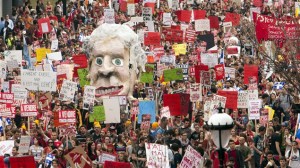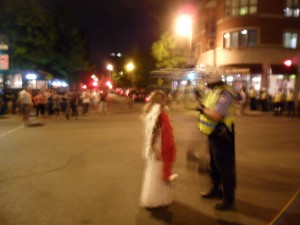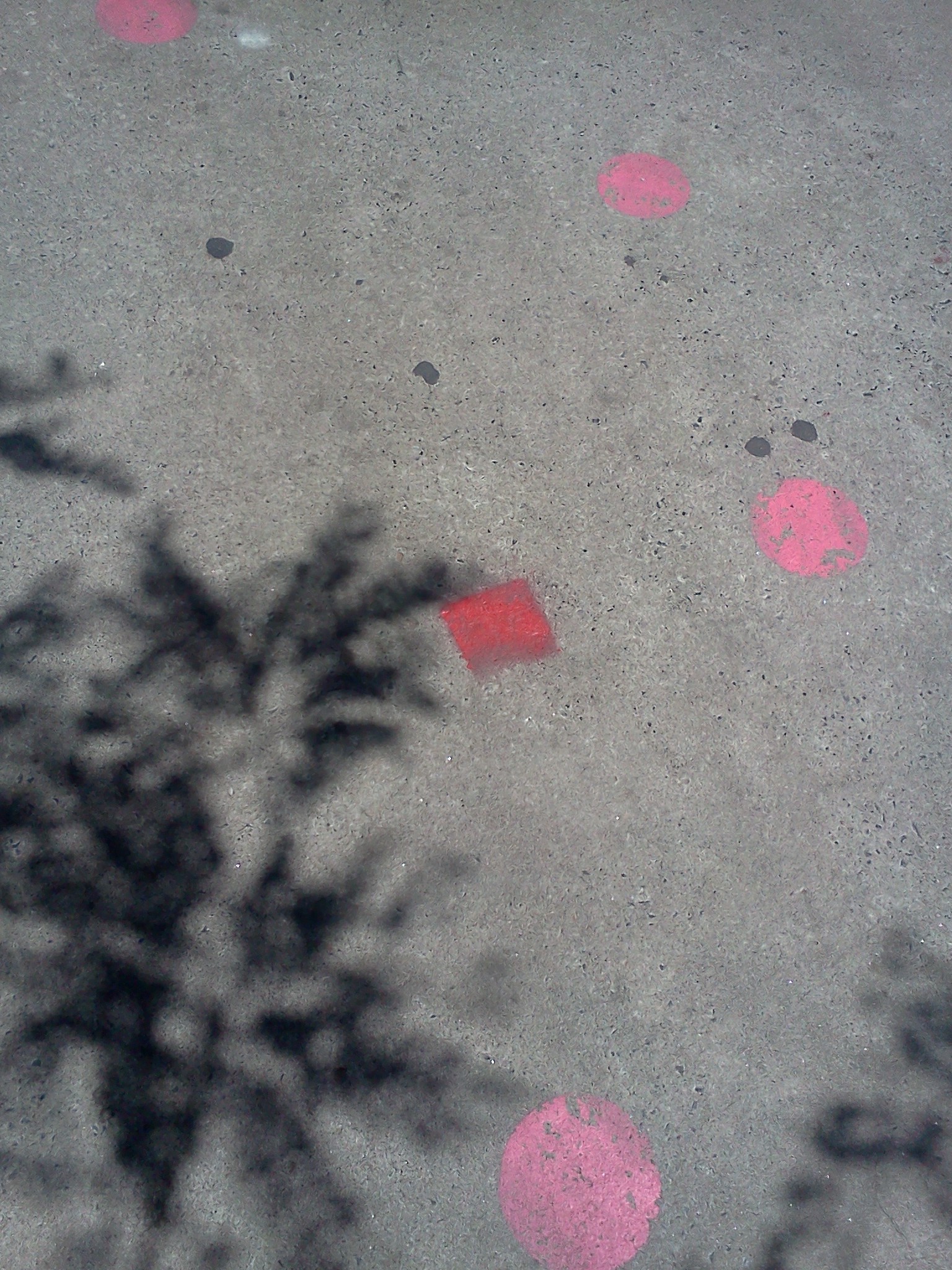Festival Wars: 2012 Montreal infringement festival in context
Montreal’s summer festival season is heating up like never before! At play this year are two very different types of festival. The first is the typical Montreal staple: carefully stage-managed and highly corporate “festivals” that promote different brands, such as the F1 or Just For Laughs Festival. The second, joining in this year, is the festival of cultural resistance that has burst onto the streets of Montreal: it’s a loud, carnivalesque, and often chaotic theatre involving hundreds of thousands of activists who are demanding a more just society.
Massive street protest against Law 78
Amidst the clanging of the casseroles, sea of red squares, and Occupy masks, the Infringement Festival, Montreal’s infamous countercultural event, is celebrating the veritable explosion of arts and theatre activism in the city with over 50 performances!
For its 9th edition, running from June 14 to 24, the Montreal infringement festival is joining the masses in using the arts to challenge the neoliberal agenda and reclaim the culture! Celebrating Freedom of Expression, activist performances and a broad range of eclectic, independent, and controversial art of all forms, the Infringement Festival is modelled on the original 1947 Edinburgh Fringe, which was an artistic protest against corporate elitism and exclusion of local artists.
At the infringement festival, artists and audiences of all backgrounds are invited to create a charged environment where people come together to take chances, push boundaries, explore uncharted territory, and to do so without corporate interference or having to pay any fees. Designed as an arts democracy, the Infringement Festival empowers communities, artists, and audiences to take charge of the culture and use it as a tool for social justice.
Set mostly in the Plateau and Red Light District (Quartier des Spectacles), this year the festival features over 50 shows and events, including street theatre, experimental performances, visual arts, music, spoken word, strange picnics and activist films. Some performances include Occupy Montreal’s Chorale du Peuple & Mr. Parker Quebec, the Candyass Cabaret and Red Light District Walking Tour, the Smoke ‘n Mirrors show, infringement therapy, Pyrometheus (fire arts), Sirène by Jacqueline van de Geer and the Dumpster Dive Art Drive vernissage. The activist venues are Café Cleopatre, the Fresh Paint Gallery, L’Escalier, Midway Tavern, Barfly, Concordia Co-op Bookstore and the outdoor Place Émilie-Gamelin. With so many acts playing on its various stages, the infringement festival is the perfect complement to the arts activism being carried out on the streets!
Velma Candyass performs – with red squares!
(photo by Georges Dutil)
The past year has witnessed widespread oppression against the population in the form of anti-democracy Law 78, bans on masks, attacks on students’ rights to affordable education, and ferocious police brutality. Exacerbating the problem is the ongoing corporate takeover and Disneyfication of the city, including the needless demolition of Montreal’s Lower Main by a corporate developer, an irreplaceable part of Canada’s most endangered National Historic Site. Add to this the rapidly rising cost of housing and food (while wages remain stagnant), over 30,000 homeless people living on the streets because the government refuses to care for them, and a myriad of other problems associated with disaster capitalism, from feelings of anger and hopelessness and increased radicalization amongst the citizens and state-sponsored violence against the protesters. The common denominator in all these attacks against the public is a neoliberal agenda designed to bolster corporate power and profits at the expense of people and democracy.
Montrealers, never people to turn away in the face of adversity, are fighting back with creative flair. As a result of the government’s attacks against the population, there has been an explosion of arts activism in the city. The protests have been occurring on a daily basis since 13 February 2012, when students began boycotting their classes after the government attempted to nearly double the cost of their tuition. On May 18, the government passed Law 78 to try and limit the students’ rights to protest, but the plan backfired and now the general population has joined together to create the ongoing festival of cultural resistance.
Protest “angel” tries to calm riot cop
Everyone from elderly grandmothers and entire families to students, eco-warriors and even lawyers are marching to demand entrenched rights and freedoms be respected, to show solidarity, and to demand social justice and a better future for the generations to come. They are banging on casseroles in the tradition of the charivari from New France, holding nude protests in the streets, sporting red squares and wearing (now-banned) masks. They are protesting with various forms of cultural resistance to challenge the neoliberal policies being imposed from above on the population. Theirs is a festival of cultural resistance on a scale never-seen-before in Montreal.
Nude Protest against the F1
Colliding with this new festival of cultural resistance is Montreal’s famous tourist draw: the so-called festival season. Every year various corporate festivals take over the city, often at the expense of taxpayers. The government’s rationale for these expenditures is that the festivals attract tourist dollars, and the concept is so ingrained in Montreal that the city even created a Place des Festivals in the heart of the rebranded Quartier des Spectacles to solidify Montreal’s brand as a true festi-ville.
The heads of these corporate festivals are generally unimpressed with their new competition, and are demanding that the protests avoid their festivals or stop altogether. For example, Gilbert Rozon, head of the Just for Laughs Festival has come out in favour of Law 78 and tuition hikes while simultaneously trying to blame students, instead of the government, for the unrest in the streets. He even met with students to try and bolster his pro-government position, to which they responded that they would attend the festivals to inform festival-goers about the dire situation facing all Quebecers.
Entering the fray next was the F1 Grand Prix Festival, considered Canada’s largest tourist attraction. In this case, true one-percenters such as pampered billionaire Bernie Ecclestone and race car driver Jacques Villeneuve lashed out against protesters, revealing that their priorities lie not in social justice, but rather in making money at all costs. The two scandalously turned a blind eye as pro-democracy protesters were slaughtered by security forces in Bahrain, the site of another F1 car race. “I can’t call this race off. Nothing to do with us,” said Ecclestone at the time, demonstrating the F1’s complicity with a regime that shuns democracy and uses deadly violence against its own citizens.
When Montrealers protested against the F1, police were deployed to beat them back and intimidate them with helicopters and a massive police presence. During the race day itself, citizens were politically profiled by police and security forces, sparking criticism by student leaders because it’s illegal.
Police arresting F1 protester
Like sore thumbs, Rozon, Ecclestone and Villeneuve have differentiated themselves from the vast majority of Quebec’s artists, entertainers, and producers, who clearly support the red square and resulting festival of cultural resistance. In fact, over 2600 Quebec artists of all stripes recently spoke out after Quebec Minister of Culture, Christine St. Pierre, suggested the famous red square worn by the bulk of progressive Quebecers symbolizes “violence and intimidation.” She made the comments after Fred Pellerin, a famous Quebec poet, storyteller and singer, declined an award due to the democratic crisis in the province. Given the fact that the red square actually signifies unsustainable student debt, or being “squarely in the red”, she later apologized for her ridiculous and distasteful statement.
Student leader Gabriel Nadeau-Dubois with red square
Even the once-activist Fringe Festival appears to be on board with the other corporate festivals, having actually re-named itself after a corporation (St. Ambroise Beer). The “St. Ambroise Fringe Festival” now hopes that instead of using the arts for social change, that the activists will drop the struggle to “come in and buy more beer” – in order to support their corporate brand, presumably. Meanwhile, following incidents last year whereby political artists were banned yet again from the St. Ambroise Fringe Festival, their Public Relations machine has been in overdrive trying desperately to persuade the public that they do indeed represent “Freedom of Expression” and an “unbeatable neighborhood feel,” despite the fact they were caught on video blocking artists and censoring their critical message.
For years people have been making demands that the St. Ambroise Fringe Festival stop exploiting artists and return to its activist roots, and for years the St. Ambroise Fringe has been ignoring them. While there were hopes that the new Fringe Manager (appointed in 2010) might listen, she dashed those hopes last year when she authorized exclusion against unwanted artists.
In addition to having her security apparatus harass, ban, and intimidate artists, the Fringe Manager also “filed a police report” against them after they presented her with a free trip to the Buffalo infringement festival, in the form of a giant cheque. The hope was that she would accept the opportunity to learn about more responsible arts management and then apply them at the Fringe (eg: artists pay nothing at the Buffalo infringement festival, whereas she charges them approximately $500 – 700 to play).
Activists present Fringe Manager with giant cheque
Astonishingly, despite using both the Montreal police force and her own security apparatus to suppress her critics, the Fringe Manager actually tried to paint herself as the victim of intimidation in the sordid affair.
The question arises as to why the corporate festivals detest the festivals of resistance so much, and why they feel so threatened by their very existence. The activists, after all, do not typically disrupt the corporate festivals, but rather raise awareness at them to inform the public about the dire political situation in Quebec. Furthermore, why do the corporate festivals seem to be firmly on the side of the government? Beyond the obvious fact that the government largely subsidizes the corporate festivals, they also have several other things in common:
- They receive a lot of funding from corporations.
- Every year, they privatize public space and fence it off for their events.
- The occupied space is tightly-controlled, in the same way shopping malls are.
- They employ security guards to search bags and keep out “undesirables”, such as homeless people, activists and political artists.
- They are heavily involved in sales, corporate marketing and cross-branding.
- They expect visitors to buy the products they are marketing.
- As with banks, every year their prices and policies are “tweaked” to maximize income.
- Select “administrators” often earn a lot of money, while most workers are often paid little or nothing at all. Sometimes artists must even pay to play.
- Festival-goers may watch shows but cannot perform or actively participate.
10. They contribute to the gentrification of neighbourhoods and the Disneyfication of culture.
Despite the use of sophisticated PR techniques to sell these festivals to tourists and the public, whether these corporate festivals are actually good for the culture is questionable. Whether or not their spokespeople are credible enough to merit being listened to is also worthy of discussion. When the majority of Quebec’s artists loudly support the activists’ right to protest, why should anyone care what pampered billionaires, wealthy race car drivers, and questionable producers have to say about the real issues on the streets?
F1 Billionaire Bernie Ecclestone
Historically, festivals were celebratory community events that highlighted some unique aspect of the community. Their purpose, in addition to celebrating specific themes and providing entertainment, was to offer people a sense of belonging and as a means for unifying the community. Simply put, authentic festivals were organic and designed to meet human needs. They were certainly not designed as marketing opportunities for corporations.
Corporate festivals operate under a very different premise from authentic festivals. Their objective is to co-opt something meaningful (such as Jazz music or once-activist Fringe theatre) in order to transform it into a corporate opportunity for marketing, branding, sales and advertising. The problem is that the more a festival is taken over by corporate interests, the less authentic it becomes. As the ads blossom all over the place, the artists and event become compromised, playing second fiddle to the corporations. Public space is privatized and security guards begin searching bags. The warm and quirky community vibe of the festival’s past is soon replaced with an often Disneyfied atmosphere where consumption is encouraged and critical thinking is unpopular. In a nutshell, these corporate festivals signify the commodification of culture and, as such, should be looked at with a critical eye.
In contrast, the festival of resistance in the streets and the infringement festival are both wide-open events. Anyone can participate, as artist and/or spectator. These festivals do not select the performers, charge participants to play or censor any message – plus they are both festive and activist at the same time. They provide participants with the tools to celebrate their activism by using the arts for social justice, on the stages and the streets.
In one final irony this year, infringement festival artists managed to break through the St. Ambroise Fringe Festival’s security cordon in order to give a speech on the stage. This was made possible because ELAN (English Language Arts Network) was holding a community “schmoozer” event and had invited them. With the activists permitted access to the St. Ambroise Fringe, festival-goers were treated to free red squares, being handed out by “Dr. Anonymous,” and an activist message on the stage about the endangered Lower Main and the infringement festival’s Red Light Walking Tour and 50 other acts.
Activists gain access to Saint Ambroise Montreal Fringe stage
Despite jokes that “the sky would fall” if the activists were permitted to speak on the St. Ambroise stage, the inclusive event demonstrated the exact opposite. It showed that by being inclusive, the St. Ambroise Fringe Festival can learn a lot from the infringement festival about current cultural issues, and can generate solidarity in the community instead of antagonism. If the Fringe wants to rescue itself from its corporate conundrum, whereby an activist community festival has been transformed into a corporate marketing opportunity, it needs to begin seriously dialoguing with artists about what the community actually wants and start making amends for its past mistakes.
Meanwhile, the infringement festival is excited to provide a forum for arts activism, where artists can perform in a safe environment, away from the riot police, and where a dialogue about politics is encouraged – and challenging the status quo is au courant.
The Montreal infringement Festival runs from June 14 – 24, and details about the performances can be found on the website.
One final reflection? Painted onto the sidewalks in the Quartier des Spectacles are both red circles and red squares. Ironically the red circles were painted on by city workers to signify the brand of the entertainment district, at the expense of the taxpayer.
Sidewalk near Berri-UQAM metro in the Quartier des Spectacles
The red squares, on the other hand, were painted by activists, illegally. Ironically, despite the fact it is the exact same act of painting red shapes on the sidewalk, the circle is advertising to officially brand the entertainment district, whereas the red square, a potent symbol of cultural resistance, expresses disapproval of the same government funding the Quartier des Spectacles. Like the shapes on the sidewalk, the corporate festivals and the festivals of resistance both share traits of festivity, but differ in politics, purpose, and vision of the future. That one is both permitted and entrenched while the other is often declared illegal should be cause for considerable reflection.











